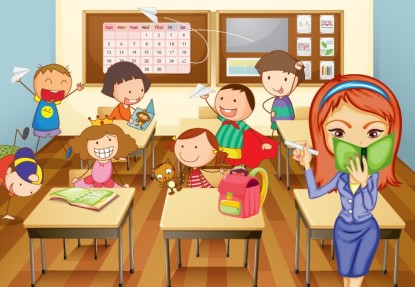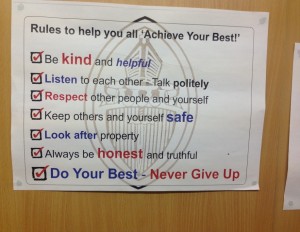Effective teachers need to address an endless list of requirements in order to manage their classrooms in a way that allows children to learn successfully. Whilst most elements of teaching are interlinked, one thing that undoubtedly underpins our teaching regardless of situation or circumstance is behaviour management. Perhaps this is why so many trainee and newly qualified teachers struggle to refine their behaviour management strategies, particularly because we often haven’t had the time to establish our ‘teacher presence’ and gain full respect within our classroom. Similarly, behaviour management will be a concern for all teachers regardless of their experience at the beginning of each new school year, when they are allocated a whole new cohort of students.
National priority.
The Department for Education (2012) aims to give schools the powers they need to provide a safe and structured environment in which teachers can teach and children can learn.
They expect the following points from schools:
- All pupils to show respect and courtesy towards teachers and other staff and towards each other.
- Parents to encourage their children to show respect and to support the school’s authority to discipline its pupils.
- Head teachers to help to create a culture of respect by supporting their staff’s authority to discipline pupils and ensuring that this happens consistently across the school.
- Governing bodies and head teachers to deal with allegations against teachers and other school staff quickly, fairly and consistently in a way that protects the pupil and at the same time supports the person who is the subject of the allegation.
- That every teacher will be good at managing and improving children’s behaviour.
Drawing on these government expectations, behaviour management is essential because as teachers, we want the children in our classroom to be flourishing, growing, happy and able to learn. This is almost impossible if we have poor behaviour management skills, which is why it is so important not to view behaviour management and effective classroom teaching as two separate entities. In other words, if a child is engaged at the correct level and stimulated by an effective lesson, they are far less likely to lose interest and as a consequence become disruptive. Similarly, it is difficult to deliver an effective lesson if your behaviour management strategies are not properly implemented. We are aware that we cannot talk about everything in relation to behaviour management as the list would be endless. However, we want to underpin a few points to consider when you come to managing a class.
So let’s try to unpick a few points to consider in relation to behaviour management:
- Differentiate- All children respond differently to different approaches, which is why it is so important to develop successful pedagogical strategies which allow you to really understand the individual needs and circumstances of each child in your class.
How to address this:
As teachers, we need to be able to differentiate our approach in a way that addresses the individual needs of the children in our class. For example, whilst I have observed praised being used effectively in the classroom, I am also aware that there are children who do not respond well to praise. Some children react negatively to public praise and would perhaps prefer this to be communicated privately or in a less verbal way, whilst other children embrace the attention and love to be praised in front of their peers. This is why it is essential to be aware of which strategy regarding praise works for the individuals in your class. (See more on differentiation here.)
- Know the underlying cause- You need to dig deep into finding out why a child may not be responding to your class behaviour strategies.
For example, social learning theorist Albert Bandura (1961) suggests that behaviour is learned through the environment in which children are exposed to. In other words, children observe adults and how they behave and almost replicate their mannerisms. This is proved through a social experiment that Bandura conducted in 1961. Watch below:
These findings support the message that children learn social behaviours such as aggression through the process of observational learning: through watching the behaviour patterns of another person.This experiment is closely linked to how children may behave in the classroom. For example, children are affected by many environmental factors such as their home life, which then affects the way that they behave. You could argue this point further by mentioning the close link between children with social, emotional and behaviour difficulties and the stability of their family life.
Furthermore, behaviour specialist Dr Jesse Earle (2013) states that children born either to mothers in cohabiting relationships where the parents had separated, or to solo mothers who had not married the natural father, had three times as many behaviour problems in comparison to children born in stable married families.
How to address this:
It is important to take into account and understand each child’s background in your classroom. For example a child that misbehaves frequently may have significant problems at home that you are not so aware of. To be an effective teacher you would be aware of any possible children that have underlying social, emotional and behavioural difficulties.
- Be reflective – short term and long term –
It is important to adapt our teaching styles over time. Teacher expectations that were acceptable many, many years ago are undoubtedly not acceptable in this day and age. For example, it was not until 1986 that child beating was stopped in schools. We are aware that this is an extreme example of how times have changed: if this were to happen today a teacher would most certainly lose their job and damage their career. This was stopped because it got to the stage that it became violent and children feared going to school. It was established that this was not an effective way to manage behaviour due to the fact that it didn’t create a positive and safe teaching environment for children to learn in.
So what about other behaviour methods that do not work? Behaviour expert ‘Paul Dix’ (http://www.pivotaleducation.com/keynotes-2/) argues that the classic method of writing a child’s name on the board as a ‘naming and shaming’ technique is an old-school way to manage behaviour. In my view, displaying a child’s name on a visual behaviour management resource, or writing a child’s name on the board both seemed like fairly harmless ways of reprimanding bad behaviour. Moreover, as this is a method I have seen used time and time again I was not quick to question it. However, Paul explained how doing this could not only be potentially damaging for a child’s self-esteem but also how it could in fact stimulate further bad behaviour from a child who actively seeks a reaction or acknowledgement from their peers. Disciplining a child by displaying their name somewhere that the whole class can see almost validates a misbehaving child’s desire for a response, or could even be seen as a goal for a child who has subscribed to a ‘naughty’ label as a sort of self-identity.
How to address this:
Paul suggested a more effective method of keeping track of bad behaviour is to record the names of the children in question, but to do so privately in a notebook rather than in a place that is visible to the rest of the class. I stand by the pedagogy that good behaviour should be noticed more often than bad behaviour; “students benefit from classrooms where behaviour management is used to promote positive behaviours and encourage learning ” (Siddiqui, 2008). Through this, the children learn about the right behavioural expectations rather than the wrong.
The above points that we have covered tie into our five top tips for behaviour management:
5 TOP TIPS ON BEHAVIOUR MANAGEMENT
1-Promote positive behaviour- Doing something small such as rewarding well behaved children at the end of the week with golden time or a positive letter home can show that positive behaviour does not go unrecognised. It is also crucial to recognise the good behaviour in your class rather than focusing all your attention to the bad.
In Bill Rogers’ model, the black dot represents the negative, disruptive behaviour of certain individuals or the class as a whole; the white square represents the positive behaviour of the majority or the normally good behaviour of an individual. By focusing on the black dot, we are forgetting the white square. This illustrates the need to keep things in perspective and helps to avoid using sweeping statements such as ‘I have such a naughty class’, ‘I do not know how to control him/her’, ‘they are disrupting everyone’s learning’ etc… (Bill Rodgers, Behaviour management strategies)
2-Lay down the law – When you start your teaching post, it is important to show that you are aware of the behaviour expectations. Set the class rules collectively and come to an agreement of how the class should behave.
Below is an example of school rules that were written by children contributing their ideas in classes. This added more meaning to the rules for the children.
3- Be consistent (follow through what you promised/said) This is important to note as children will struggle to take you seriously as a teacher if you say that you will do something without following through. For example, saying that you will remove their break time because they did not work well in class and then forgetting/not bothering with the sanction anymore will result in the child believing that you do not take the rules seriously as a teacher. This also works vice versa: if you say that you will reward a class with a treat and do not follow through, it can make the children lose trust in you.
4- Know the appropriate sanctions and notice what works/does not work– Sometimes it can difficult to know which sanction to give a child if they are doing the same thing over and over again whilst been given the same sanction. I believe that the child should not enjoy the sanction that they have been given. I have seen many ineffective and effective sanctions whilst being in school. Something effective such as giving them writing tasks whilst the rest of the class enjoy play time works quite well as I noticed that children hate missing out on play time whilst they have been kept behind. However we should be mindful not to present writing as a negative activity, so this needs to be done sensitively. I have also seen children being sent outside of a lesson for ‘time out’, however I believe that some children may see this as an excuse to get out of class so as teachers we should be aware of this.
5-Building relationships with your students- Establishing a high-quality relationship and rapport with the child is a key component of behaviour management, yet it would seem apparent to state that this is something that cannot be taught overnight. This raises the importance of having a good relationship with the entire class in order to be able to manage all of the children effectively.
Often we walk into the classroom as teachers and expect the children to be well behaved and listen to what we ask them to do. I believe that this is not how behaviour management works; the teacher needs time to build their authority in the classroom by establishing good relationships. “The more students know and respect you, the more they will behave for you in the classroom” (Education world, 2012).
Concluding thoughts
There is so much to consider in relation to this theme of teaching and learning. Behaviour is a great concern to many new teachers as it is closely related to how effective the learning is from both the teacher’s and the student’s perspective. Through what we have observed in school and within the academic articles that we have read, we have tried to collate some key themes highlighting ways in which teachers can effectively manage behaviour within their classrooms; we hope this has been of some use to the reader. For more information, please visit some of the links below.
Further reading on issues related to behaviour management techniques and expectations:
http://www.huntingenglish.com/2013/12/10/top-ten-tips-behaviour-management/ – Top 10 tips for behaviour management
https://www.gov.uk/government/uploads/system/uploads/attachment_data/file/269686/ensuring_good_behaviour_in_schools.pdf – Government expectations regarding behaviour management
https://www.tes.co.uk/teaching-resource/Top-10-Behaviour-Management-Tips-3006435/ – TES behaviour management tips
References:
- Bobo Doll experiment (2011) Available online: <http://www.simplypsychology.org/bobo-doll.html>[Accessed 21/11/14].
- Department for Education (2012) Ensuring good behaviour in schools. Available online: <https://www.gov.uk/government/uploads/system/uploads/attachment_data/file/269686/ensuring_good_behaviour_in_schools.pdf> [Accessed 22/11/14].
- Earle, J. (2013) “Emotional and behavioural problems” BMA Board of Science [online] Available:< file:///C:/Users/sz84/Downloads/growingupinuk_may2013_chp7.pdf > [Accessed 22/11/14].
- Education Word (2012) Available online: <http://www.educationworld.com/a_curr/columnists/mcdonald/mcdonald013.shtml>[Accessed 30/10/14].
- Effective behaviour management from Bill Rogers (2013) Available online: <http://headguruteacher.com/2013/01/06/behaviour-management-a-bill-rogers-top-10/ >[Accessed: 21/11/14].
- Siddiqui, M.H. Chapter 4.2. Guidance for managing student’s behaviour (2008) Guidance and Counselling. P. 94.




